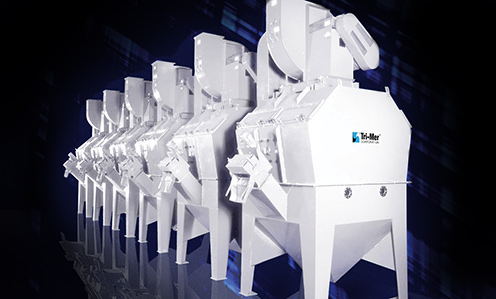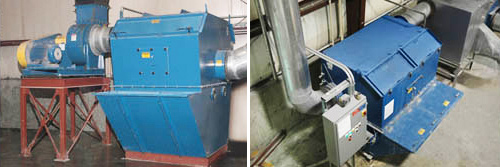

Wax products producer achieves 99% efficiency using Tri-Mer Dust Collection Equipment.
The company’s first priority was a system that would collect fugitive particulate with consistently high efficiency. Low utility cost and minimal maintenance were also important. Wet particulate collection was specified at the outset because the vapor carried with the airstream would quickly blind baghouse, cyclonic and other dry systems.
Whirl Wet dust collection equipment; 5000 and 7500 cfm, respectively, were used. In one area, materials are dispensed as dry particles in powdered form into lidded kettles. As these materials are added, the Whirl Wet pulls outside air through the lid, preventing release of particulate. Other materials are generally added as solids or as liquids. Components are mixed into molten materials.
Vapors from the jacketed, insulated mixing kettles, approximately 200°F, duct to the larger Whirl Wet unit. Particle size distribution of the incoming airstream is primarily between 5 and 10 microns. Particulate loading is heavy, because sticky vapors are entrained in the airstream.
Notably, the Whirl Wet has no internal moving parts and is self-cleaning, so the sticky character of the material does not present maintenance issues for the collector, or the ductwork.
The Whirl Wet also facilitates a process where moisture must be removed under negative pressure, (standard design is 20" of negative pressure) its fan pulls out the moisture-laden air, saving process time and steps. The Whirl Wet removes a substantial amount of particles from the airstream.
To control process odors and VOCs, a 3000 lb. active carbon bed filter was placed after the 5000 cfm Whirl Wets units. Sandwiched between them is a bank of DOP-type “furnace filters” that first remove the smaller (1-3 micron) particulate.
This assures that the costly fluidized bed carbon filter doesn’t blind. Blinding would occur as a result of vapors suspended in the warm exhaust stream. The filters allow the air to cool and the particles to solidify on the media. Without the filter bank, the carbon filters have a service life of 4-5 days. With it, it’s 3 months.
To compensate for the higher pressures and fan velocity, silencers were provided on both Whirl Wet units to attenuate noise to a level of 70-75 dB for the larger unit and 80-81 dB for the smaller unit.
The two Whirl Wets are constructed with mild steel material with a proven service life of 20+ years.

Droplets eventually accumulate on the de-misters, but their PVD construction makes removal an easy task. Energy generated inside the unit will not allow the system to clog under any operating conditions, including high particulate loading.
Utility costs are minimized due to a low power draw – despite the greater fan requirements – and the fact that water use is low. Water level is maintained automatically, and make-up water is only necessary to compensate for evaporation or sludge removal.
Whirl Wet operates in the 99%+ efficiency range for a wide variety of applications and over a wide range of micron sizes for both soluble and insoluble particulate. It is widely used throughout the CPI, and within the food, pharmaceutical and aggregate sectors.